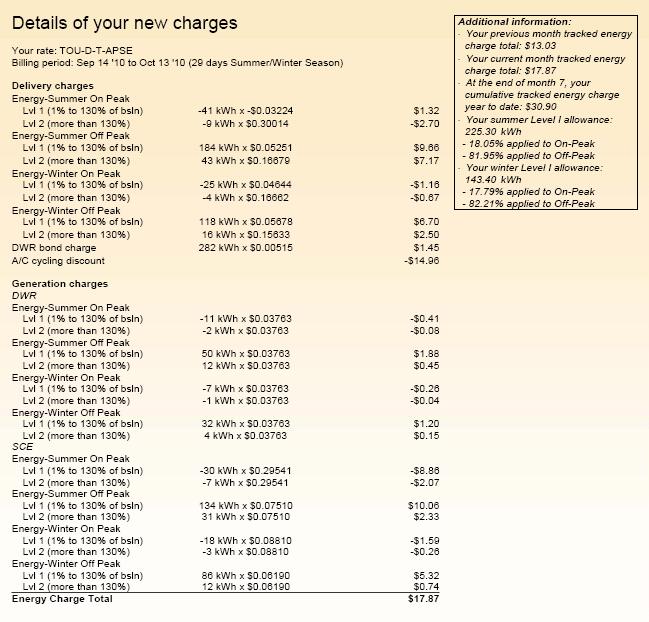garygid
Well-known member
Handling the billing (credit) for over-generation during one day's (or one billing period's) TOU periods is the main confusing part of PV usage.
Presumably the Peak, Off-Peak, and Low-Night usages are accumulated separately, minute by minute and day by day, for the whole billing period, within the meter. Then the meter is only read once for bilking purposes.
If all the P, OP, and LN usages are not negative (as accumulated for the whole billing period), the calculations are fairly "easy", and almost understandable, once one has the correct "Total Rates" for the Tariff being used.
But, with over-generation, the P (or OP, & rarely LN) "usage" will be negative. How is that handled and credited?
1. The kWh excess in each TOU category can be just carried forward to the next month and a settle-up billing done at the year end, if any "excess" still exists. But, months without "excess" are billed normally.
2. The kWh excess in one category can be used to offset (reduce) usage in the other TOU categories. This way, P generation can offset EV charging, but with no real benefit for the "Peak" generation.
3. Cash Credit can be calculated, often at the lowest tier rate of the generation period, and the "cash" applied to pay your bill. The problem comes that the credit is usually only for the "energy" (E) part of the billing, and not for the "distribution" (D) part. So, getting a credit for "E", but paying for "D+E", one can end up getting credit for LESS (or MORE) than one kWh used later, or in another TOU time slot. It can be as bad as "generate 4 kWh to buy one", or as good as "generate 1 kWh to buy five".
The exact rates and division of the costs between "E" and "D" are required to determine the best strategy.
If you can get 24¢ "E" credit per kWh for the month's over-generation at Peak, and apply that to 6¢ "D+E" charges at Late Night, you get 4 for one, a VERY good deal.
However, if you get only 9¢ cedi for "E" and pay a minimum of 13¢ for "D+E", you are better off trying to get 1-for-1 by running the meter backwards.
Yes, since the bilking methods do NOT appear to be "public" (or even well known within the PU), this over-generation topic seems to be a "great mystery". :roll:
Presumably the Peak, Off-Peak, and Low-Night usages are accumulated separately, minute by minute and day by day, for the whole billing period, within the meter. Then the meter is only read once for bilking purposes.
If all the P, OP, and LN usages are not negative (as accumulated for the whole billing period), the calculations are fairly "easy", and almost understandable, once one has the correct "Total Rates" for the Tariff being used.
But, with over-generation, the P (or OP, & rarely LN) "usage" will be negative. How is that handled and credited?
1. The kWh excess in each TOU category can be just carried forward to the next month and a settle-up billing done at the year end, if any "excess" still exists. But, months without "excess" are billed normally.
2. The kWh excess in one category can be used to offset (reduce) usage in the other TOU categories. This way, P generation can offset EV charging, but with no real benefit for the "Peak" generation.
3. Cash Credit can be calculated, often at the lowest tier rate of the generation period, and the "cash" applied to pay your bill. The problem comes that the credit is usually only for the "energy" (E) part of the billing, and not for the "distribution" (D) part. So, getting a credit for "E", but paying for "D+E", one can end up getting credit for LESS (or MORE) than one kWh used later, or in another TOU time slot. It can be as bad as "generate 4 kWh to buy one", or as good as "generate 1 kWh to buy five".
The exact rates and division of the costs between "E" and "D" are required to determine the best strategy.
If you can get 24¢ "E" credit per kWh for the month's over-generation at Peak, and apply that to 6¢ "D+E" charges at Late Night, you get 4 for one, a VERY good deal.
However, if you get only 9¢ cedi for "E" and pay a minimum of 13¢ for "D+E", you are better off trying to get 1-for-1 by running the meter backwards.
Yes, since the bilking methods do NOT appear to be "public" (or even well known within the PU), this over-generation topic seems to be a "great mystery". :roll:


